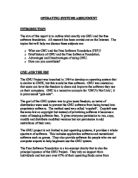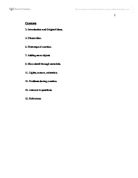Zanna and Rempel (1988) took the three-component model to a more detailed level, they put forward the four main features of attitudes. The first feature is that of the three-component view (where the attitude comes from), the second is that the attitude is represented in memory where they are recalled and used or altered. The third feature is the actual evaluation of the target, whether a person, object or situation. The final feature is the target that the attitude is directed towards.
Although the three-component view is more detailed, sometimes a more simplified approach is needed, which is where the one and two component views are useful. This is because both the one and two-component models present a simpler cause and effect style interpretation, as in the one-component model positive or negative stimuli is the cause and the affective evaluation leading to an attitude is the effect.
Attitudes can come from many sources, these have been grouped generally into four main areas, which shall be discussed. The first area to be discussed is how attitudes arise from thoughts and beliefs (cognitive information). A theory that was formed in the area of cognitive information is the theory of reasoned action (Fishbein & Ajzen, 1975). This theory put forward that attitudes are formed in part by beliefs already apparent in the mind, these beliefs then influence the evaluation of the object, person or situation to form the attitude. The beliefs about the stimuli are what we already know about it and the attitudes and views we hold about it as stored in our memory, these beliefs however then may update and change the attitude about the stimuli on future occasions and once more information has been attributed with the stimuli. A stimulus however may have many different beliefs associated with it that appose each other, and the complex the beliefs about the stimuli the longer it may take to form an attitude about it.
Attitudes can arise from direct experience with the stimuli, and sometimes there is no apparent reason for the positive or negative attitude towards the stimuli. In an experiment performed by Saegert, Swap and Zajonc (1973) subjects were put in a room with one of five other participants for 40 seconds, yet some were paired together more frequently than other pairings. It was discovered that the pairings that had been together the most had a greater liking (and hence greater positive attitude towards) of each other than the pairings that hadn’t been in the room together many times, even if they hadn’t been talking at all in the room. So even though there may be no obvious reason for the evaluation of the person a positive attitude can be formed.
Attitudes can also be formed as a result of conditioning, the type of conditioning to consider is classical conditioning. This type of conditioning involves the pairing of neutral objects with another object that has either a positive or negative attitude already associated with it, it is then found that the previously neutral object now has an attitude linked to that of the second object. This was demonstrated by Pavlov and his experiment with salivating dogs (although originally an experiment to display learning). Pavlov rang a bell before feeding a dog in the experiment and at first the bell produced no change in the behavior of the dog, however after this was repeated many times and then the dog began to salivate when the bell rang because the bell was then associated with a feeding. The bell in the experiment was the neutral object that the dog had no previous attitude about yet when it was associated with the arrival of food, the dog then had the same positive attitude about the bell as it does the food. This then shows that attitudes about one stimulus can be easily linked to attitudes about other stimuli by the process of classical conditioning.
Attitudes can also be positively or negatively increased by operant conditioning, by a process of either reward or punishment. If for example a child hits someone and a parent punishes the child, the previous attitude towards hitting people that the child had (which could’ve been a positive or negative attitude) would have been made more negative and the child is more likely to steer away from hitting people as it has a more negative attitude towards doing so. This would also work in the opposite direction, if the child were rewarded for hitting people they would then have a more positive attitude towards doing so. The process of operant conditioning can therefore change attitudes by others influencing the reward or punishment of the situation.
The final main area from which attitudes can be formed is the biological influence on situations. If someone is affected biologically be any form be it drugs, pain or pleasure the attitudes that person associates with various stimuli can change or be affected greatly. For example as MacDonald, Zanna and Fong (1995) researched, the affect of a high level of alcohol in the blood whilst driving can change a persons previous attitudes about how confident they are about driving (and other tasks in general). It was found that when drunk the confidence levels of the person are increased to a great extent. When previously they would have questioned their ability to drive whilst drunk, as they increase their level of alcohol in the blood, the attitude towards driving whilst drunk changes and they begin to have a more positive attitude towards driving whilst drunk. Many different drugs can change attitudes in diverse ways than what the attitudes would normally be, with respect to drinking alcohol, the attitudes are normally returned to what they previously would have been.
Having looked at the structure of attitudes and how attitudes are formed and altered it concluded that attitudes are a very complex and important element of behavior. It has been discussed that there are many different models of attitudes and the models all differ in their complexity, yet all models are correct in their own rite. The ways in which attitudes are formed are numerous and can be either a result of direct or indirect learning. The attitudes that are already formed can be changed for better or worse and a lot of the time we cannot control the changing of our attitudes. We even may not notice our attitudes towards certain stimuli changing at all.
References
Eagly, A.H. & Chaiken, S. (1998) ‘Attitude structure and function’. In D.T. Gilbert, S. T. Fiske, & G. Lindzey (Eds.), ‘The Handbook of Social Psychology’ (4th ed., pp. 269-322). New York: McGraw-Hill.
Eagly, A.H. & Chaiken, S. (1993) ‘The psychology of attitudes’. San Diego, CA and Fort Wort, TX: Harcourt Brace Jovanovich.
Petty, R.E. & Cacioppo, J.T. and Goldman, R. (1981) ‘Personal involvement as a determinant of argument based persuasion’. Journal of Personality and Social Psychology, 41, 847-855.
Zanna, M.P. & Rempel, J.K. (1988) ‘Attitudes: a new look at an old concept.’ In D. Bar-Tal and A.W. Kruglanski (eds.), ‘The Social Psychology of Knowledge’ (pp. 315-34), Cambridge: Cambridge University Press.
Saegert, S. Swap, W. & Zajonc, R. (1973) ‘Exposure, content and interpersonal attraction’ Journal of Personality and Social Psychology, 25, 234-42.
Fishbein, M. & Ajzen, I. (1975) ‘Belief, attitude, intention and behaviour: an introduction to theory and research’. Reading, MA: Addison-Wesley.







